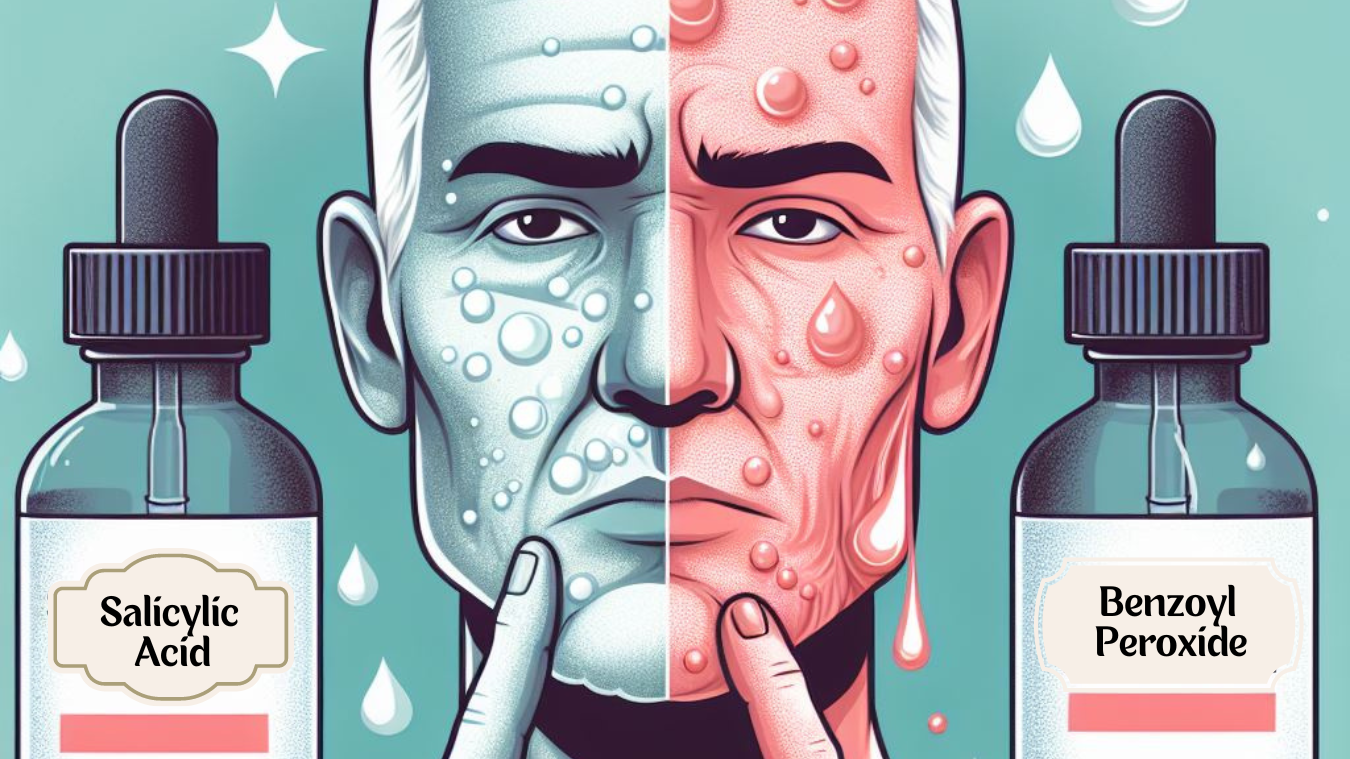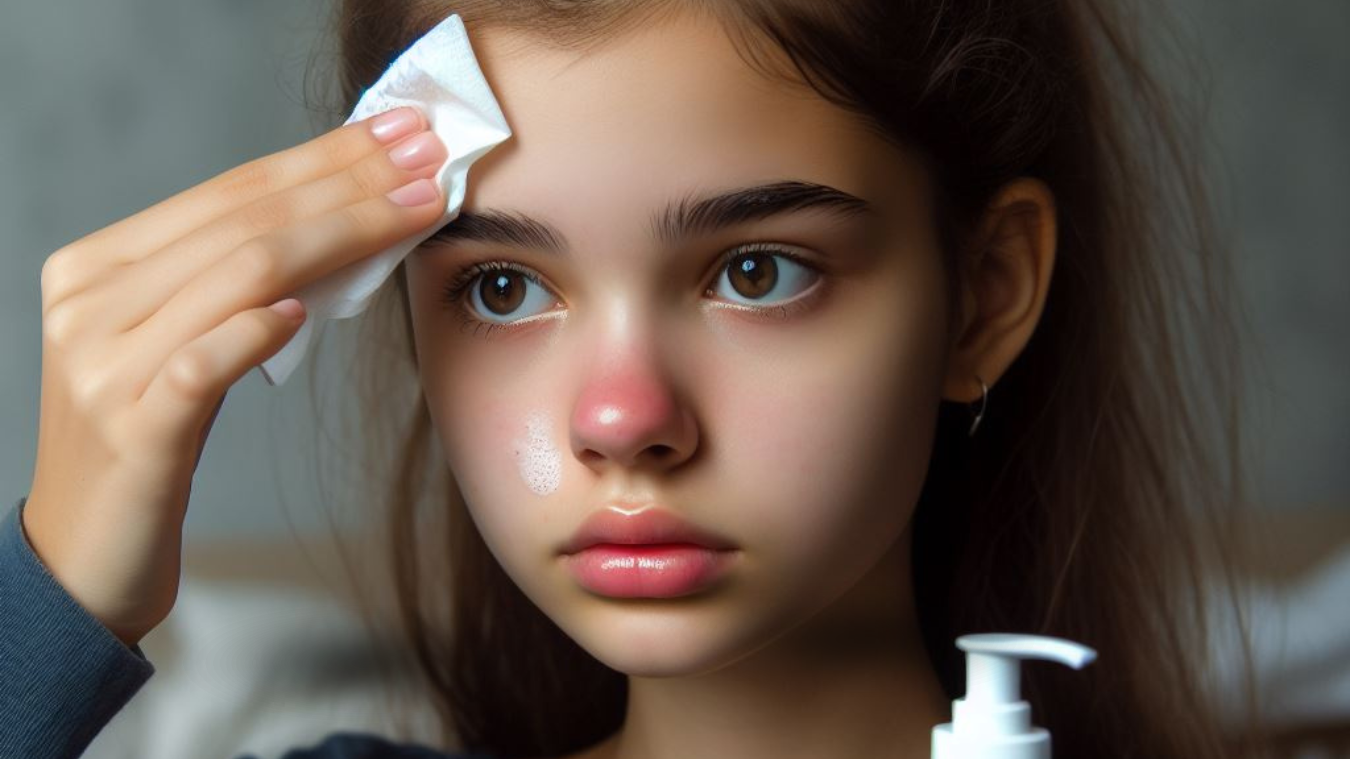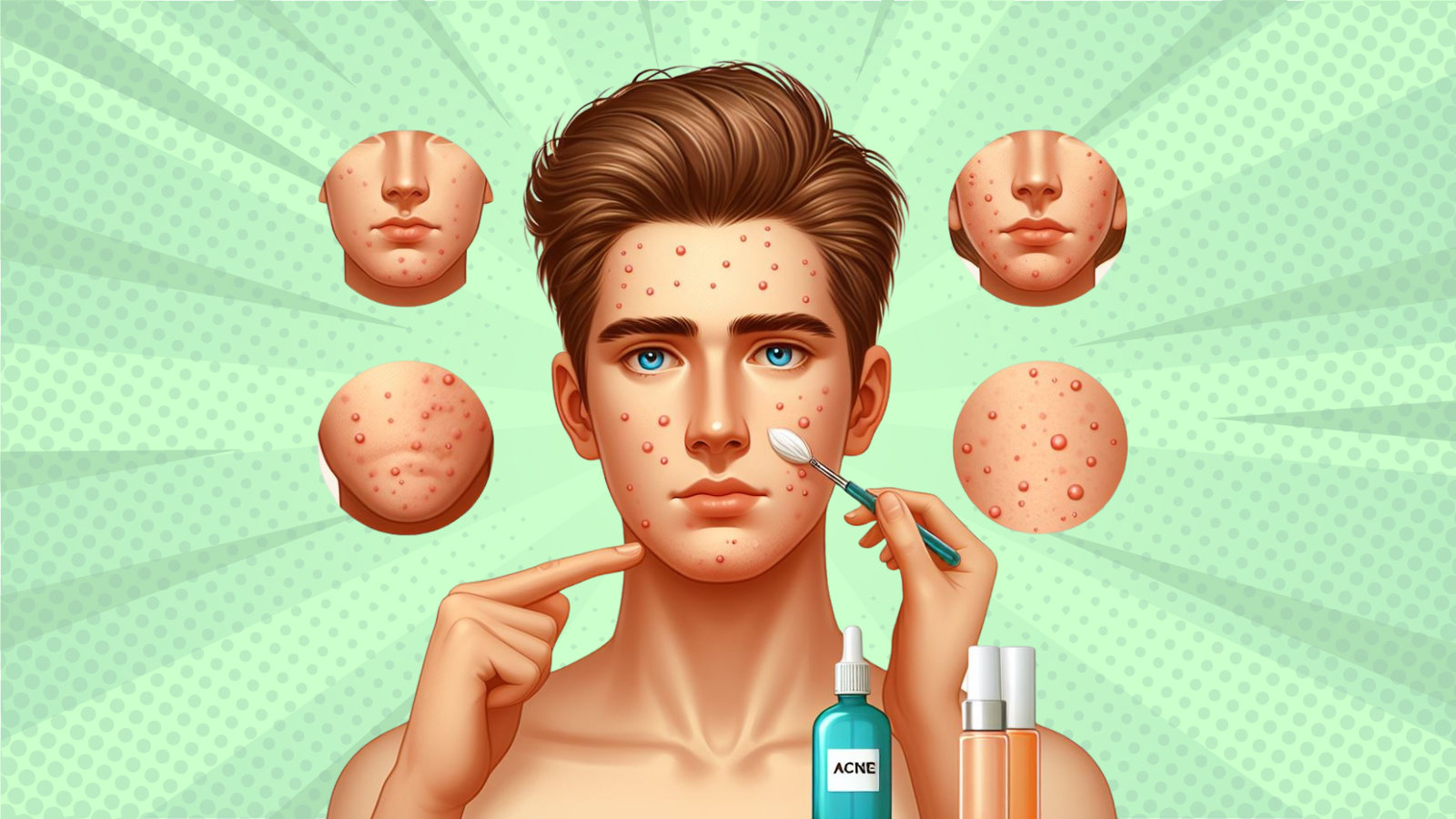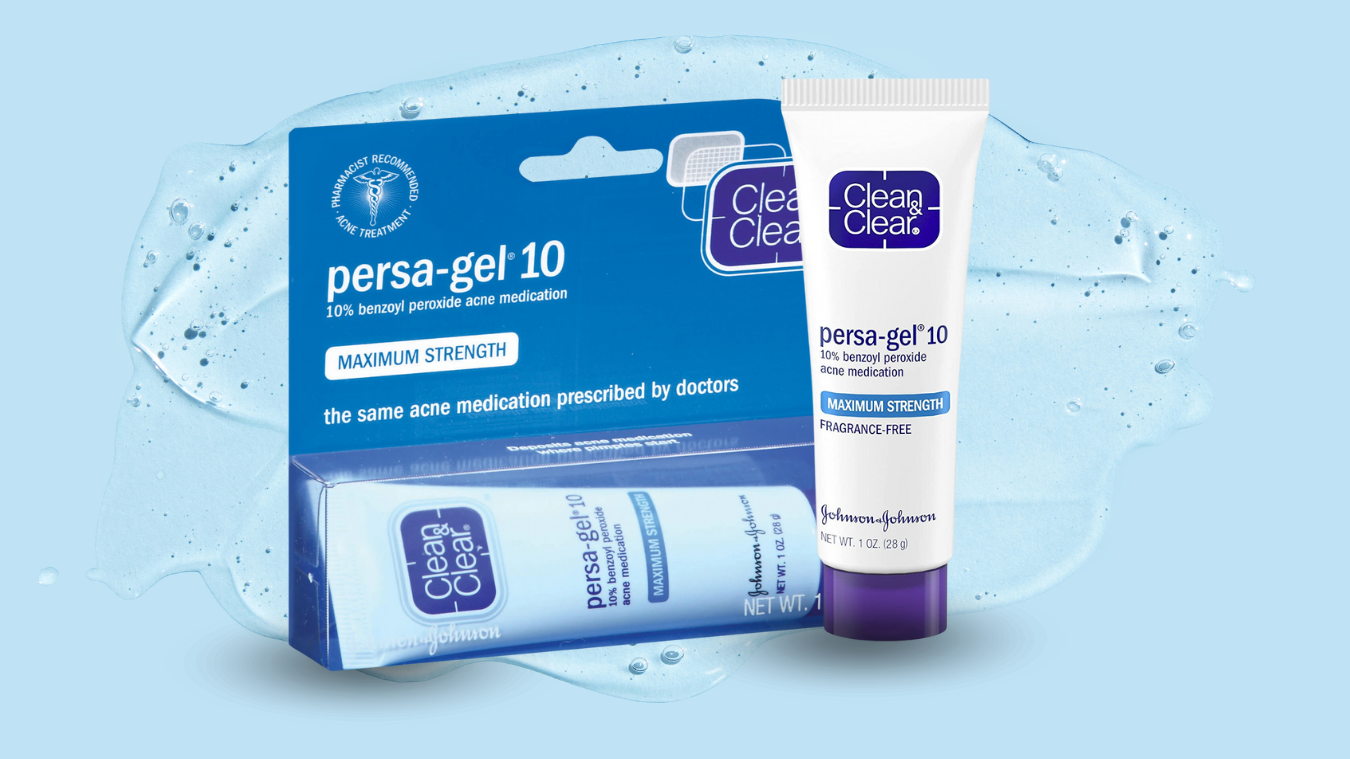Acne is a skin condition most of us know all too well. From the occasional pimple to regular breakouts, it can be frustrating and impact confidence.
The good news is, there are many effective treatments available. Two of the most popular over-the-counter acne-fighting ingredients are salicylic acid and benzoyl peroxide.
But which one should you choose for better results?
This article dives into the differences between salicylic acid and benzoyl peroxide for acne. We’ll explore how they work, their benefits, potential side effects, how to select the right one for you, and how to incorporate them into your skincare routine.
How Salicylic Acid and Benzoyl Peroxide Fight Acne
To understand which ingredient is better for your skin, let’s look at how they battle those blemishes:
Salicylic Acid: The Pore-Clearing Powerhouse
- Salicylic acid belongs to a class of ingredients called beta hydroxy acids (BHAs). It’s oil-soluble, meaning it can penetrate deep within your pores.
- Think of it as a master at dissolving the gunk that clogs pores – dead skin cells, excess oil (sebum), and debris.
- It reduces inflammation and even helps fade post-acne marks.
Benzoyl Peroxide: The Bacteria-Busting Hero
- Benzoyl peroxide is the bacteria’s worst enemy. It targets P. acnes, the main bacteria type responsible for those inflamed, red pimples.
- It also helps shed dead skin cells, preventing those pesky clogged pores from forming in the first place.
Benefits of Salicylic Acid vs. Benzoyl Peroxide
Let’s break down the specific advantages of each acne-busting ingredient:
Salicylic Acid Benefits
- Best for blackheads and whiteheads: Its main strength lies in unclogging pores and preventing these non-inflammatory acne types.
- Gentler on the skin: Typically causes less irritation and dryness compared to benzoyl peroxide.
- Anti-inflammatory properties: Helps calm down redness and swelling.
- Fades acne scars: Can help with post-acne hyperpigmentation (dark spots).
Benzoyl Peroxide Benefits
- Targets inflammatory acne: Effective against red, angry pimples (papules and pustules).
- Can prevent future breakouts: By killing acne-causing bacteria, it helps keep your skin clear.
- Available in various strengths: Gives you more flexibility in choosing a concentration suitable for your skin.
- Works with other acne treatments: Can often be combined with other acne-fighters like retinoids for increased effectiveness.
Side Effects of Salicylic Acid vs. Benzoyl Peroxide
While both ingredients are generally safe, they can come with some potential downsides:
Salicylic Acid Side Effects
- Dryness and peeling: Can cause some initial dryness and flaking.
- Minor irritation: Might cause stinging or tingling, especially for sensitive skin.
- Sun sensitivity: Increases your skin’s sensitivity to the sun, making sunscreen essential.
Benzoyl Peroxide Side Effects
- Dryness and irritation: A common culprit for dryness, redness, and irritation, particularly with higher concentrations.
- Bleaching: Benzoyl peroxide is notorious for bleaching fabrics like towels and clothing.
- Allergic reactions: While rarer, allergic reactions can occur.
How to Choose: Salicylic Acid or Benzoyl Peroxide?
The ultimate question: which is better for your skin? Consider these factors:
Acne type:
- Blackheads and whiteheads: Salicylic acid usually your best bet.
- Inflamed pimples (papules and pustules): Benzoyl peroxide would take the lead.
- A mix of both types: You might benefit from using both ingredients.
Skin sensitivity:
- Sensitive skin: Start with salicylic acid, as it’s generally less irritating.
- Tolerant skin: Benzoyl peroxide might be a good option.
Severity of acne:
- Mild to moderate acne: Either ingredient could work.
- Severe acne: See a dermatologist for prescription-strength treatments.
Recommended Products
Here are some recommended products to consider if you want to try salicylic acid or benzoyl peroxide:
For Salicylic Acid:
- Murad Time Release Acne Cleanser: This cleanser contains 0.5 percent salicylic acid and helps reduce the appearance of fine lines.
- Neutrogena Oil-Free Acne Wash Pink Grapefruit Foaming Scrub: A maximum-strength wash gentle enough for daily use.
- Clean and Clear Deep Cleansing Toner for Sensitive Skin: Suitable for sensitive skin, this formula is easy to apply with a cotton ball and is non-drying.
- Philosophy Clear Days Ahead Moisturizer: Combats acne with salicylic acid while preventing skin dryness with additional ingredients like oligopeptide-10.
- Dermalogica Sebum Clearing Masque: Removes excess oil without over-drying and is fragrance-free, making it suitable for those sensitive to scents.
- Juice Beauty Blemish Be Gone: An ideal spot treatment for occasional breakouts.
For Benzoyl Peroxide:
- Mountain Falls Daily Acne Control Cleanser: Contains 1 percent benzoyl peroxide and is suitable for sensitive skin.
- TLP 10% Benzoyl Peroxide Acne Wash: A daily cleanser with a stronger concentration of acne-fighting ingredients, yet gentle on all skin types.
- Neutrogena Clear Pore Facial Cleanser/Mask: This versatile product can be used daily as a cleanser or left on longer as a mask.
- Acne.org 2.5% Benzoyl Peroxide: A gel formulation that effectively penetrates the skin without causing excessive dryness.
- Neutrogena On-the-Spot Acne Treatment: Contains 2.5 percent benzoyl peroxide and dries quickly on the skin.
- Clean and Clear Persa-Gel 10: A prescription-strength spot treatment containing 10 percent benzoyl peroxide.
These products offer different concentrations and formulations to cater to various skin types and preferences.
It’s essential to choose one based on your skin’s sensitivity and the severity of your acne. Remember to patch test any new product and introduce it gradually into your skincare routine.
How to Use Salicylic Acid and Benzoyl Peroxide
To get the most out of these acne fighters, follow these tips:
- Start slow: Begin using them once a day and gradually increase frequency as tolerated.
- Patch test: Test new products on a small skin area before applying them to your entire face.
- Moisturize: Combat dryness with a lightweight, oil-free moisturizer.
- Sunscreen is a must: Protect your skin with a broad-spectrum sunscreen of SPF 30 or higher.
- Listen to your skin: If severe irritation occurs, stop using the product and see a dermatologist.
How to Use Benzoyl Peroxide Specifically:
- Wash hands thoroughly: Prevents bleaching clothes or hair.
- Treat the whole area: Apply to the entire affected area, not just individual spots, to prevent future breakouts.
- Use old towels and pillowcases: To minimize potential bleaching.
Can You Use Salicylic Acid and Benzoyl Peroxide at the Same Time?
Generally, dermatologists recommend focusing on one of these ingredients at a time, especially if you have sensitive skin. Using both together can increase the risk of irritation.
However, if your acne requires a more aggressive approach, using them separately at different times of the day might be an option:
- Option 1: Salicylic acid in the morning, benzoyl peroxide at night.
- Option 2: Use them on alternate days.
Important: Before combining them, always consult a dermatologist for personalized advice.
The Takeaway
So, which is ultimately better for your acne, salicylic acid or benzoyl peroxide? There’s no one-size-fits-all answer. The best choice depends on your individual skin type, acne severity, and how your skin reacts to each ingredient.
Here’s a quick recap:
- Salicylic acid: Ideal for blackheads, whiteheads, and milder acne. Also well-suited for sensitive skin.
- Benzoyl Peroxide: A good option for red, inflamed pimples and moderate acne.
Don’t be afraid to experiment a bit to see what works best for you. If over-the-counter options aren’t cutting it, a dermatologist can offer even more effective treatments and personalized recommendations. With a little understanding and patience, you’ll be on your way to achieving clearer, healthier skin!
Frequently Asked Question
Q. What’s the difference between salicylic acid and benzoyl peroxide when it comes to treating acne?
A. Salicylic acid primarily works by exfoliating the skin and unclogging pores, making it great for treating blackheads and whiteheads. Benzoyl peroxide, on the other hand, targets acne-causing bacteria and reduces excess oil production, making it effective against inflammatory acne.
Q. Which one is better for sensitive skin: salicylic acid or benzoyl peroxide?
A. Salicylic acid tends to be milder and may be better tolerated by sensitive skin compared to benzoyl peroxide, which can sometimes cause dryness and irritation. However, individual reactions vary, so it’s essential to patch test and monitor your skin’s response.
Q. Can I use salicylic acid and benzoyl peroxide together?
A. While it’s possible to use both salicylic acid and benzoyl peroxide in your skincare routine, it’s crucial to proceed with caution, especially if you have sensitive skin. Start with lower concentrations of each and gradually increase usage if your skin tolerates it well.
Q. How long does it take to see results with salicylic acid or benzoyl peroxide?
A. Results vary from person to person, but generally, you may start noticing improvements in your acne within a few weeks of consistent use. Remember to be patient and stick to your skincare routine for optimal results.
Q. Do salicylic acid and benzoyl peroxide have any long-term side effects?
A. While both ingredients are generally safe for most people when used as directed, long-term use of benzoyl peroxide may cause dryness, irritation, and increased sensitivity to sunlight. Salicylic acid may lead to dryness and mild irritation with prolonged use. It’s essential to monitor your skin and adjust your skincare routine accordingly.
Q. Can salicylic acid or benzoyl peroxide help with acne scars?
A. While salicylic acid and benzoyl peroxide are effective at treating active acne lesions, they may not directly target acne scars. However, regular exfoliation with salicylic acid can help improve skin texture and reduce the appearance of mild acne scars over time. For more severe scarring, additional treatments may be necessary.
Q: I get all kinds of acne – blackheads, whiteheads, those big red ones…which ingredient is my superhero?
A: That’s a tough call! Both salicylic acid and benzoyl peroxide are acne-fighting powerhouses, but they specialize in different areas. Salicylic acid is your go-to for blackheads and whiteheads, while benzoyl peroxide targets those angry, red pimples. A dermatologist might even recommend a combo approach for your specific breakout needs.
Q: My skin is basically the Sahara Desert after using acne products. Help!
A: Dryness is the struggle! Salicylic acid is generally gentler than benzoyl peroxide. Start slow, with a low concentration product. And remember, moisturizer is your new skincare soulmate. Look for oil-free, lightweight options to keep your skin hydrated without clogging pores.
Q: Salicylic acid, benzoyl peroxide…can I just layer them on for double the power?
A: Whoa there! While it’s tempting to nuke those breakouts, layering these ingredients can seriously irritate your skin. Focus on one at a time, and always consult a dermatologist before going for a combo approach.
Q: I tried a product for a few days and my skin looks worse. Do I give up?
A: Don’t lose hope! Sometimes both salicylic acid and benzoyl peroxide can cause a bit of an initial breakout purge as they clear out gunk from your pores. Stick with it for a few weeks. If the irritation is severe or your acne isn’t improving, then it’s time to chat with a dermatologist about other options.
Q: Beach vacation coming up! Can I still use my acne treatments or will I turn into a lobster?
A: Both ingredients make your skin extra sun-sensitive. Sunscreen becomes non-negotiable! Slather on a broad-spectrum SPF 30 or higher, reapply frequently, and consider sun-protective clothing too. Your future clear skin will thank you.



